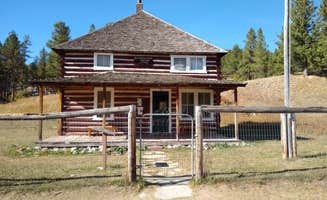Forest Service cabins near Hobson, Montana provide rustic retreats across the Little Belt Mountains at elevations between 5,000-7,000 feet. These historic structures serve as convenient base camps for exploring the surrounding wilderness, particularly during Montana's short summer season when temperatures range from 40-80°F. Winter access requires additional planning with several cabins accessible only by snowmobile or skiing when roads close.
What to do
Explore ice caves: Crystal Lake area features natural ice caves that remain frozen year-round. "The hike to the ice caves, while difficult, is SO worth it," notes Megan B. about Crystal Lake Group Campsite. This moderate to strenuous hike takes approximately 3-4 hours round trip.
Fish mountain streams: Several cabins provide direct access to creek fishing. Dry Wolf Cabin sits near a productive creek where visitors can catch native trout. "Creek nearby for water... lots of activities nearby rock hounding/fossils, hikes, small waterfall, swimming in creek," explains K B. about Dry Wolf Cabin.
Winter sports access: Kings Hill Cabin serves as a convenient winter base for cross-country skiing and snowshoeing. Its location directly off Highway 89 makes it accessible year-round. "It's right by the highway so it's accessible year-round and it's a perfect winter wonderland. The area is near Showdown Ski Bowl with tons to do," states Lindsay B. about the cabin's location.
What campers like
Privacy and solitude: Many forest service cabins offer seclusion from crowds. "We had the place to ourselves mid week it was so quiet. Lots of space between spots, easy to get into. Great get away," reports Jim about Crystal Lake Group Campsite. Most cabins sit on isolated forest parcels with few neighbors.
Comfortable rustic accommodations: Cabins provide shelter with basic amenities that make extended stays comfortable. "Cabin stays cool in the summer and has wood stove for cold winters. Propane stove makes cooking easy," notes a reviewer about the temperature control and cooking facilities at Dry Wolf Cabin.
Youth group facilities: Larger cabin complexes accommodate scout troops and youth organizations. "Each campground has cabins which hold about 11 people and tent spaces outside. The cabin do have semi-decent heating, but not AC. The bathrooms are really big and well developed (and super warm for the winter)," reports Sterling C. about Camp Rotary.
What you should know
Water sources vary: Not all cabins have running water. "Creek nearby for water (or campground a few miles up road has well and spring with potable water)," notes a Dry Wolf Cabin visitor. Bring containers to transport water from nearby sources at most locations.
Cooking facilities: Most cabins include propane stoves for cooking but require bringing your own cookware, utensils, and food supplies. With no nearby stores, pack all necessary groceries before arrival.
Reservation requirements: All Forest Service cabins require advance booking through Recreation.gov with fees typically around $60 per night. Reservations open 6 months in advance and popular summer weekends fill quickly.
Limited signage: Some forest access points lack clear markings. "There was no sign for this campsite on the highway. I just pulled off the highway where it said access to National Forest," reports David T. about his experience at Moose Creek Campground. Bring detailed maps and directions.
Tips for camping with families
Scout-friendly facilities: Camp Rotary offers facilities specifically designed for youth groups. "There is also a big 'roof building' with picknick tables to eat food," notes Sterling C., describing the communal spaces that work well for family gatherings.
Seasonal considerations: Plan family trips during peak summer season when road conditions are most favorable. "Friday night and not a soul in sight. Like other reviews - very open. Staying on the outside provides better privacy," reports David P. about visiting Crystal Lake in September when crowds diminish.
Wildlife viewing opportunities: The Little Belt Mountains support diverse wildlife including deer, elk, and numerous bird species. Early mornings and evenings offer the best viewing times near cabin clearings.
Adventure planning: The ice caves near Crystal Lake Cabin provide a memorable family adventure, though Lindsay B. notes an important geographical change: "Allegedly, Crystal Lake drained into a limestone fissure in the earth. Bummer. But it's still an insanely beautiful area with hikes up to a year-round ice cave!"
Tips from RVers
Limited cabin parking: Most Forest Service cabins have small parking areas that accommodate 2-3 vehicles but aren't designed for large RVs. Sites typically have uneven surfaces that may require leveling blocks.
Alternative dispersed options: When cabins are booked, nearby dispersed camping provides alternatives. "I just pulled off the highway where it said access to National Forest, and it appeared fairly close to the highway. There were only half a dozen sites or so, and no amenities. And of course, no cost," explains David T. about finding convenient roadside camping near Moose Creek.
Seasonal access restrictions: Most mountain roads accessing cabins close seasonally. Kings Hill Cabin remains accessible year-round due to its highway proximity, making it a reliable option when other cabin roads become impassable.


